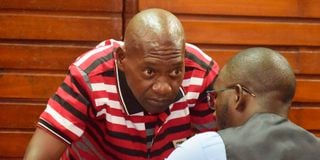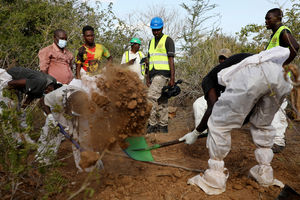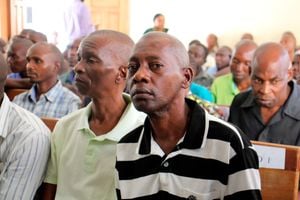
Pastor Paul Mackenzie speaks to his advocate Lawrence Obonyo at the Mombasa Law Court on September 9, 2024.
Detectives have revealed how Kilifi preacher Paul Mackenzie and his men attempted to conceal graves after burying followers of his church who were either starved to death or killed using weapons in Shakahola Forest.
A report on the graveyards, where 429 bodies were exhumed in 2023, has laid bare the tactics used to cover up the crime in a desperate bid to ensure that the deceased's bodies would never be found.
The victims are believed to have been followers of Good News International Ministries, a suspected cult led by Mr Mackenzie, who is one of the suspects in police custody.
The report presented to a Mombasa chief magistrate court by the Directorate of Criminal Investigations (DCI) details how Mr Mackenzie orchestrated a plan to ensure his victims decay without a trace.
A Forensic Imaging and Acoustic analyst with the DCI, Chief Inspector Kigen Sawe said while on a mission to search for victims of who were still alive, they came across what seemed to be cultivated land.
Unknown to them, there was no farming taking place; instead, those were graves that had been flattened.
This was the method of burial, Mr Sawe told Chief Magistrate Alex Ithuku on Tuesday.
“The concealment of graves was achieved by flattening the grave sites; the soil in this area appeared disturbed, and we could encounter loosely compacted soil, crack lines, and collapsed soil,” he said during examination-in-chief by the prosecution team comprising Victor Owiti, Jami Yamina, Yassir Mohamed, Alex Gituma, and Betty Rubia.
Mr Sawe was part of a multi-agency team consisting of detectives from Homicide, forensic experts, uniformed police officers, and representatives from various government and non-government organisations who were deployed to Shakahola on April 19, 2023, to identify graves and exhume the bodies of followers of the Good News International Church associated with Mackenzie.
Read: Tearful teen tells of forced conversion to Christianity and pain of losing mother to Shakahola cult
The officer also testified that during their search, they discovered the victims of this deadly act were being buried beneath trees.
“We also found that the graves were covered with branches. This serves as camouflage for the graves, making them difficult to identify for an ordinary person unfamiliar with the area. This was the method of operation,” said the officer while being cross-examined by Mackenzie’s lawyer, Lawrence Obonyo.
Furthermore, the witness informed the court that they also discovered crops were being planted on top of the graves.
“All of this side is a graveyard, these are crops that are germinating. This is where we retrieved about 28 bodies. When you look at that area, it is well cultivated; there was no weed,” he said while showing the court a still picture of a grave on which crops are planted.
The officer also testified that the perpetrators of this heinous acts ensured that documentation and clues that could be used to identify the deceased persons were destroyed.
“We discovered concealment of the identities of the victims by burning personal properties within the graveyard. Most of the graves were within the jurisdictions of the homesteads. The graves were shallow, less than six feet,” he said.
“This looked like a suitcase; we recovered wires that are typically found at the edges of a suitcase. Next to the burned suitcase and property, there were graveyards,” he added while showing the court an area where property believed to belong to the victims was burned.
He told the court almost all the exhumed bodies were wrapped in sheets tied at the neck and ankles.
“These are images of victims in the canopies (fasting bays), taken during the process of random search and rescue. Victims found therein appeared emaciated, and some were found dead,” the officer said.
The tools used in the forest were jembes, spades, and machetes. The main mode of transport was by motorbike and bicycles.
“We recovered death certificates, title deeds, and pamphlets. These pamphlets contained Bible verses related to the Mackenzie teaching,” he said.
A Technical University of Mombasa student ID was among the items recovered in the graveyards. There were also bags of food containing rice and cereals found in the homesteads that were used by the victims.
Mr Sawe also informed the court that the documentation of the graves was conducted in a manner that ensures the data will remain accessible for many years.
This allows anyone wishing to trace back the grave of their loved one and its exact position to do so easily.
The officer stated they utilized GPS (Global Positioning System) technology to determine the precise location of each grave.
They accomplished this by recording the exact coordinates of the grave sites, which enabled them to carry out accurate documentation.
He said that they used the data collected from the GPS device to create detailed maps of the graves, taking measurements of each grave's length, width, and depth.
“The homesteads in Shakahola are collapsing due to weather conditions; in the near future, you might not find any homestead standing there, but the data we gathered using technology will be invaluable in locating the graves,” he said.
He explained that the marking of the sites was done using numerical and Roman numerals, along with the deployment of a geographic information system.
“Each grave had a number, and the bodies were marked according to how they were arranged in the grave. We needed each body to have a number corresponding to its placement in the grave. That is how we documented it, so each body can be traced to its grave site and number,” he said.
He noted that bodies found under canopies were marked differently from those that were exhumed.
The officer said they documented 265 homesteads and 22 canopies. There were water pans in each homestead, and the officers documented more than 14.
Additionally, he said there were fasting bays in certain homesteads within the forest.
The court also heard that crime scene video documentation and searches were conducted through intelligence-led information, random searches, marking, cordoning, and using two video cameras, with the footage subjected to playback checks using software.
“This was to detect any defects and ensure free flow of playback without any time lapse in the video file,” he said.
Another Forensic Crime Investigator, Senior Sergeant Livingston Lihanda, was also among those deployed to the forest when the mass death was uncovered.
“When I arrived, my role was to document the crime scene. Documentation involved taking still pictures of the graves, the canopy, and the bodies. I conducted the documentation using my camera,” he said, adding that informants assisted them in identifying these graves.
The grave diggers aided them in removing the soil.
“I would then take still photos of the grave and the body before retrieval,” he said.
Mr Lihanda told the court that the suspects attempted to camouflage the graves to conceal their crime.
“If one can dig a grave, cover it, and then plant cowpeas on top, then it is camouflage. The forest where the exhumation was conducted was a graveyard, not normal ground,” he said.
According to the officer, only the government has the mandate to sanction burial in mass graves.
“Under ordinary circumstances, people do not bury their loved ones in mass graves the way the victims of the Shakahola massacre were buried in the forest,” he said.
He stated that bodies were assigned unique identifiers during the exhumation; the same process occurred at the autopsy, where different identifiers were given to the bodies after the medical procedures were conducted.
“I was involved in both the exhumation and the autopsy, but my work was limited to documentation through photography,” he said.
In this case, Mackenzie and his 95 co-accused persons are facing charges of manslaughter, accused of killing 238 people in the Shakahola forest.







